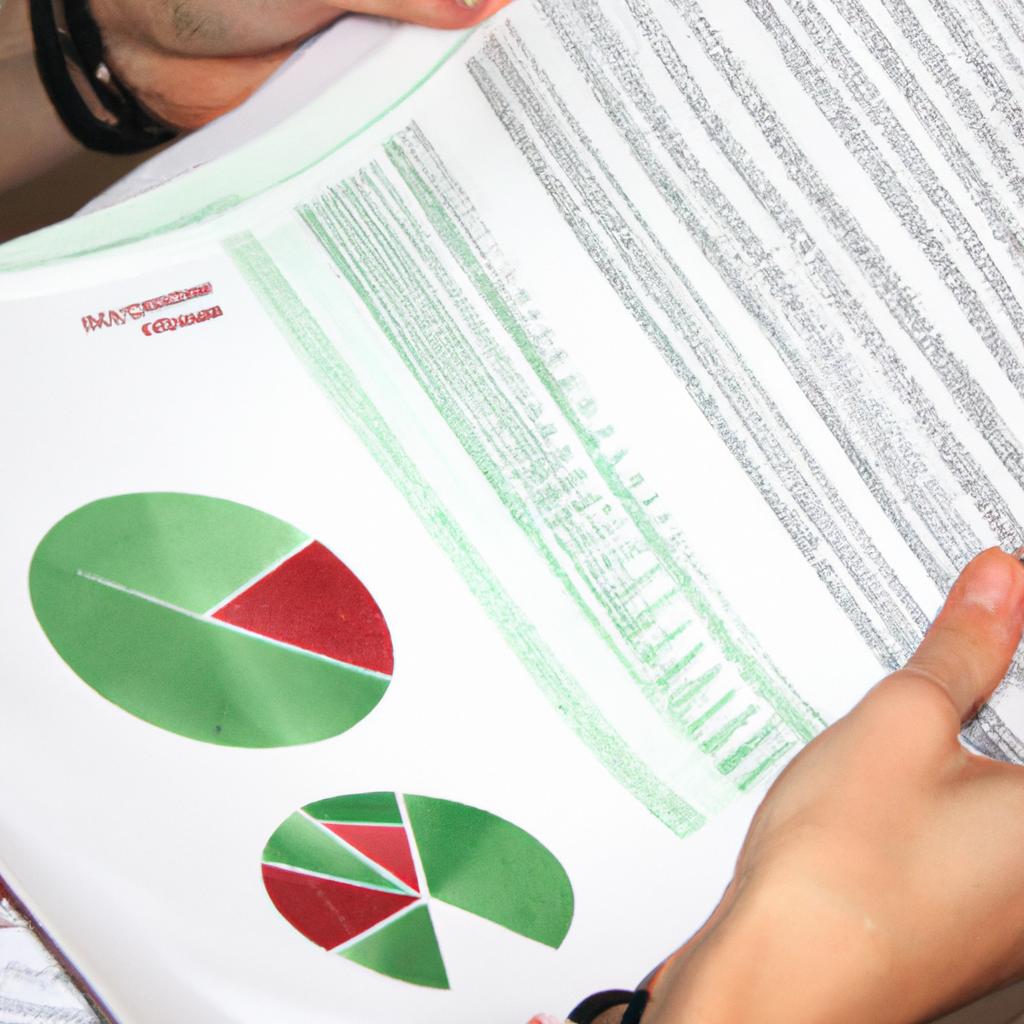Bond Valuation: The Key Factors in Investing Business > Bonds

Bond valuation is a crucial aspect of investing in the business world. It involves determining the intrinsic value of a bond, which helps investors make informed decisions about buying or selling bonds. Understanding the key factors that influence bond valuation is essential for successful investment strategies. For instance, consider a hypothetical case study where an investor wants to evaluate the value of a corporate bond issued by Company X. By analyzing various factors such as interest rates, credit quality, and maturity date, the investor can ascertain whether the bond is undervalued or overvalued.
One important factor influencing bond valuation is interest rates. Changes in interest rates have a significant impact on bond prices. When interest rates rise, newly issued bonds offer higher yields than existing bonds with lower coupon rates, leading to decreased demand and subsequently lowering their market values. Conversely, when interest rates decline, older bonds with higher coupon rates become more attractive due to their relatively higher yield compared to new issues. Therefore, understanding how changes in interest rates affect bond prices is vital for accurate valuation.
Another critical factor affecting bond valuation is credit quality. The creditworthiness of the issuer determines the level of risk associated with holding its bonds. Bonds issued by financially sound companies or governments with high credit ratings tend to have lower default risks and tend to be more valuable in the bond market. On the other hand, bonds issued by companies or governments with lower credit ratings have higher default risks and are typically priced at a discount to compensate investors for the increased risk. Evaluating the credit quality of an issuer through credit rating agencies’ assessments is crucial in determining the fair value of a bond.
The maturity date of a bond also plays a significant role in its valuation. Bonds with longer maturities typically carry higher interest rate risk than those with shorter maturities. This is because changes in interest rates over time can have a more substantial impact on a bond’s present value when there is a greater time period until its maturity. Investors often consider their investment objectives and risk tolerance when deciding between bonds with different maturity dates.
In addition to these key factors, other elements such as inflation expectations, market liquidity, and general economic conditions can also influence bond valuations. Inflation erodes the purchasing power of fixed-income investments like bonds, so higher expected inflation rates may lead to lower bond prices. Market liquidity refers to the ease at which bonds can be bought or sold without significantly impacting their prices. Bonds with high liquidity tend to be easier to trade and may have narrower bid-ask spreads compared to less liquid bonds, affecting their valuations.
Overall, understanding how interest rates, credit quality, maturity dates, inflation expectations, market liquidity, and economic conditions interact is essential for accurate bond valuation. By considering these factors and conducting thorough analysis, investors can make informed decisions about buying or selling bonds based on their perceived intrinsic values relative to prevailing market prices.
Bond Face Value
Bond Valuation: The Key Factors in Investing Business > Bonds
One of the key factors to consider when investing in bonds is the face value. The face value, also known as the par value or principal amount, represents the amount that will be repaid to bondholders at maturity. For example, let’s consider a hypothetical case study where Company XYZ issues bonds with a face value of $1,000 each.
To better understand the significance of face value, it is important to highlight its role in determining the return on investment for bondholders. Bond prices fluctuate based on changes in interest rates and market conditions. However, regardless of these fluctuations, at maturity, bondholders are entitled to receive the full face value of their investment.
Investors often perceive higher face values as an indication of stability and trustworthiness from issuers. A higher face value implies a larger commitment by the issuer towards repayment upon maturity. This perception can evoke confidence among investors and potentially attract them towards such high-value bonds.
Considerations regarding bond face values go beyond perceived stability; they extend into practical matters as well:
- Liquidity: Bonds with lower face values may offer more liquidity since they are typically more affordable and appealing to a wider range of investors.
- Diversification: Investors seeking diversification within their portfolios may find it easier to achieve through smaller denominations offered by lower-face-value bonds.
- Accessibility: Lower-face-value bonds can provide individual retail investors with opportunities to invest in fixed-income securities without requiring large capital outlays upfront.
- Market Dynamics: Changes in investor sentiment or economic conditions can impact demand for bonds across different sectors irrespective of their respective face values.
In summary, understanding the concept of bond face value is crucial when evaluating investment options. It serves as both an indicator of stability and trustworthiness while influencing considerations regarding liquidity, diversification potential, accessibility for retail investors, and overall market dynamics surrounding various bonds.
Moving forward, let’s delve into another essential factor in bond valuation: the coupon rate.
Coupon Rate
In the previous section, we discussed the concept of bond face value and how it represents the principal amount that will be repaid to the bondholder at maturity. Now let’s delve into another crucial factor in bond valuation: the coupon rate.
The coupon rate is the annual interest rate paid by the issuer of a bond to its bondholders. It is expressed as a percentage of the bond’s face value and determines the periodic cash flows received by investors throughout the life of the bond. To illustrate this point, consider a hypothetical case study involving Company XYZ issuing bonds with a face value of $1,000 each and a coupon rate of 5%. This means that each year, investors holding these bonds would receive an annual interest payment equal to 5% of $1,000, which amounts to $50.
Understanding how the coupon rate impacts bond valuation is essential for investors. Here are some key points to consider:
- Higher coupon rates result in higher periodic interest payments, providing investors with a steady income stream.
- Bonds with lower coupon rates may be less attractive if prevailing market interest rates are higher since investors can potentially earn more from other investments.
- The relationship between the coupon rate and market interest rates affects the price or value of existing bonds. When market interest rates rise above a bond’s coupon rate, its price tends to decrease because new issuances offer higher yields.
To further grasp these concepts, let’s take a look at a comparison table showcasing different scenarios based on varying coupon rates and their impact on investment returns:
| Coupon Rate | Annual Interest Payment (based on $1,000 face value) |
|---|---|
| 3% | $30 |
| 5% | $50 |
| 7% | $70 |
As depicted in this table, higher coupon rates not only provide larger interest payments but also potentially enhance investment returns over time.
Understanding the relationship between bond prices and their remaining time until maturity is vital for investors in assessing risk and potential return on investment.
Bond Maturity
Bond Maturity: Understanding the Timeframe of Investment
When investing in bonds, understanding their maturity is crucial. Bond maturity refers to the length of time until a bond reaches its full repayment. This section will examine the concept of bond maturity and highlight its significance in investment decisions.
To illustrate this point, let’s consider an example. Imagine you are considering two different bonds with similar coupon rates but varying maturities. Bond A has a maturity of 5 years, while Bond B has a maturity of 10 years. As an investor, it is important to weigh the potential benefits and risks associated with each bond before making a decision.
There are several key factors related to bond maturity that investors should take into account:
- Duration: The duration represents the weighted average timeframe for cash flows from a bond, taking into consideration both coupon payments and final principal repayment.
- Interest Rate Risk: Bonds with longer maturities generally have higher interest rate risk since they are exposed to changes in market interest rates over an extended period.
- Liquidity: Depending on the specific characteristics of a particular bond issue, some bonds may be more or less liquid as they approach their maturity date.
- Reinvestment Risk: When shorter-term bonds mature, investors face reinvestment risk as they need to find new investment opportunities at potentially lower interest rates.
These factors can influence an investor’s decision-making process when selecting between bonds with differing maturities.
The following table provides an overview comparing Bond A (with a 5-year maturity) and Bond B (with a 10-year maturity), highlighting how these key factors differ based on their respective maturities:
| Factors | Bond A | Bond B |
|---|---|---|
| Duration | Shorter | Longer |
| Interest Rate Risk | Lower | Higher |
| Liquidity | Potentially higher | Potentially lower |
| Reinvestment Risk | Potentially lower | Potentially higher |
In summary, bond maturity plays a significant role in investment decisions. Understanding the associated factors such as duration, interest rate risk, liquidity, and reinvestment risk is crucial for investors to make informed choices. In the subsequent section about “Yield to Maturity,” we will explore another important aspect of bond valuation.
Transitioning smoothly into the next section without explicitly stating “step,” let’s now delve into the concept of Yield to Maturity.
Yield to Maturity
Bond Maturity: A Crucial Factor in Bond Valuation
In the previous section, we explored the concept of bond maturity and its significance in bond valuation. Now, let us delve deeper into this topic by examining some key aspects related to bond maturity.
One important consideration when assessing bond maturity is the time remaining until the bond reaches its face value or principal amount. To illustrate this point, consider a hypothetical case study involving two bonds with different maturities. Bond A has five years remaining until it matures, while Bond B has only one year left. Generally, as the time to maturity decreases, the risk associated with the bond also diminishes. This is because shorter-term bonds are less exposed to interest rate fluctuations and other market uncertainties compared to longer-term bonds.
When evaluating a bond’s maturity, investors should also take into account their own investment objectives and risk tolerance. Bonds may be classified into short-term (one to three years), medium-term (four to ten years), or long-term (over ten years) categories based on their respective maturities. The choice between these categories depends on factors such as an investor’s liquidity needs and desired returns over specific time horizons.
To further highlight the importance of bond maturity, let us examine some emotional responses that investors commonly experience when considering different maturities:
- Sense of security: Shorter-term bonds often provide investors with a sense of security due to their faster approach towards maturity.
- Potential for higher returns: Longer-term bonds can evoke feelings of optimism among investors who seek greater potential for capital appreciation over an extended period.
- Uncertainty about future interest rates: Investors may feel cautious about committing to longer-term bonds if they anticipate significant changes in interest rates during that timeframe.
- Desire for flexibility: Some individuals prefer investing in shorter-maturity bonds to maintain flexibility in reallocating funds more frequently.
Consider the following table comparing characteristics related to different bond maturities:
| Bond Maturity | Time Remaining (Years) | Risk Exposure |
|---|---|---|
| Short-term | 1-3 years | Low |
| Medium-term | 4-10 years | Moderate |
| Long-term | Over 10 years | High |
In conclusion, bond maturity plays a crucial role in the valuation of bonds. Investors must carefully consider the time remaining until a bond matures and align it with their investment objectives and risk tolerance. The emotional responses that different maturities may evoke further highlight the importance of this factor in investment decision-making.
Next, we will explore another significant aspect related to bond valuation: credit rating.
Credit Rating
Yield to Maturity (Continued)
Building on the concept of yield to maturity, it is essential to consider another crucial factor in bond valuation: credit rating. Credit rating agencies evaluate the creditworthiness of issuers by assessing their ability to meet financial obligations and repay debt. This evaluation plays a significant role in determining the risk associated with investing in bonds.
To illustrate the importance of credit ratings, let’s examine a hypothetical case study involving two companies issuing bonds: Company A and Company B. Company A has an excellent credit rating due to its stable financial position and consistent revenue streams. On the other hand, Company B operates in a volatile industry with unpredictable cash flows, resulting in a lower credit rating. Despite offering similar yields to maturity, investors may be more inclined to invest in Company A’s bonds due to its higher credit rating, reflecting lower default risk.
Understanding how credit ratings influence bond valuations can help investors make informed decisions about their investment portfolios. Here are key points to consider:
- Default Risk: Bonds with higher credit ratings typically have lower default risks compared to those with lower ratings.
- Interest Rates: Companies with better credit ratings often benefit from lower interest rates when borrowing funds through bond issuance.
- Market Perception: Investors’ perception of an issuer’s credibility can impact demand for its bonds, affecting market liquidity and pricing.
- Risk Appetite: Investors willing to take on greater risk may choose bonds with lower credit ratings that offer higher yields.
Below is a table comparing two hypothetical companies based on their respective credit ratings:
| Company A | Company B | |
|---|---|---|
| Credit Rating | AAA | BBB |
| Default Probability | Low | Moderate |
| Interest Rate | 3% | 5% |
| Investor Confidence | High | Medium |
As demonstrated by this comparison table, credit ratings provide investors with valuable insights into an issuer’s financial stability and the associated risks. These factors heavily influence bond valuation and investor decision-making.
Moving forward, we will delve into another critical aspect of bond valuation: market interest rates. By understanding how market interest rates impact bond prices, investors can effectively navigate the dynamic landscape of fixed-income investments without missing out on potential opportunities.
Market Interest Rates
Having explored the significance of credit ratings in bond valuation, we now turn our attention to another critical factor – market interest rates. Understanding how these rates impact bond prices is essential for investors seeking to make informed decisions.
Market Interest Rates:
One example that illustrates the influence of market interest rates on bond values is as follows: Consider a hypothetical scenario where an investor purchases a 10-year corporate bond with a fixed coupon rate of 5%. In this case, if prevailing market interest rates rise above 5% after the purchase, new bonds issued by other companies will offer higher coupon payments to attract investors. Consequently, the value of our purchased bond decreases because its fixed coupon payment becomes less attractive compared to newly available options offering higher returns.
To shed further light on the relationship between market interest rates and bond prices, let us examine some key considerations:
- Indirect Relationship: Market interest rates and bond prices generally move in opposite directions. When interest rates increase, existing bonds with lower coupon payments become less appealing relative to new issues offering higher coupon payments.
- Duration Sensitivity: Longer-term bonds are more sensitive to changes in market interest rates than shorter-term bonds. This means that their price fluctuations are greater when there are variations in interest rates.
- Yield-to-Maturity (YTM): YTM represents the total return anticipated from holding a bond until maturity. As market interest rates fluctuate, it directly affects the YTM and consequently influences the price of bonds.
- Economic Outlook Impact: Changes in economic conditions can impact market interest rates. For instance, during periods of economic growth or inflationary pressures, central banks often raise benchmark interest rates which subsequently affect overall borrowing costs.
| Key Considerations |
|---|
| Indirect Relationship between Market Interest Rates and Bond Prices |
| Duration Sensitivity of Bond Prices |
| Impact of Yield-to-Maturity (YTM) on Bond Values |
| Influence of Economic Outlook on Market Interest Rates |
- Investors should carefully monitor market interest rates as they directly affect the value of bonds.
- The sensitivity of bond prices to changes in interest rates is influenced by their duration, with longer-term bonds being more volatile.
- Yield-to-maturity provides a measure of the anticipated return from holding a bond until maturity and fluctuates with market interest rates.
- Macroeconomic factors, such as economic growth and inflation, can influence market interest rates.
Incorporating these considerations into investment decision-making processes will empower investors to navigate the complexities associated with bond valuation based on prevailing market interest rates. By understanding how these rates impact bond prices, investors can make informed choices that align with their financial goals and risk tolerance.






